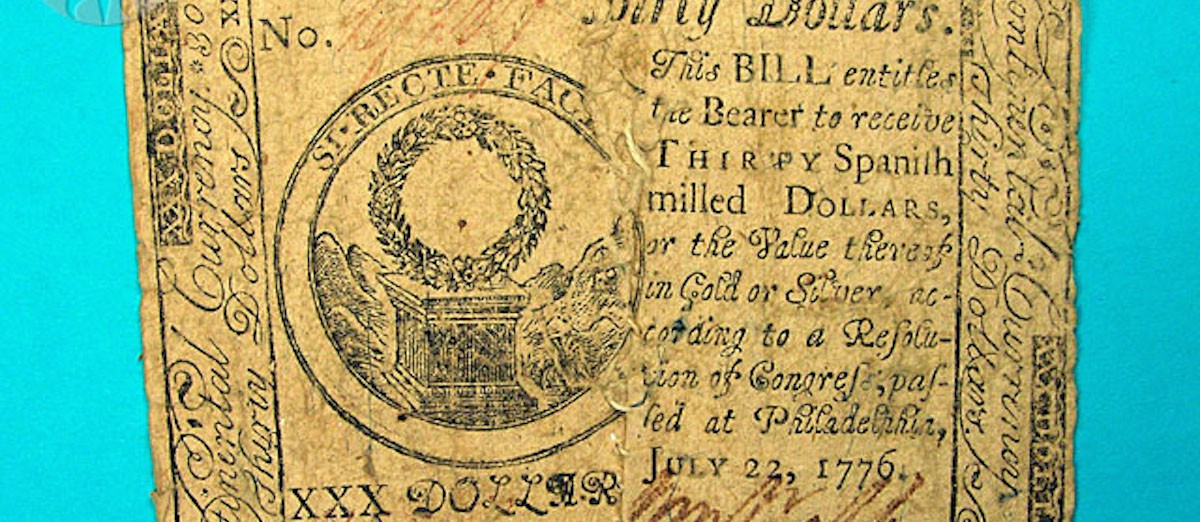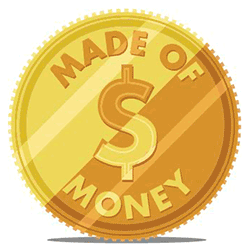

I have a $10 trillion banknote on my fridge. It is completely real, issued by a bank with watermarks and a unique serial number. It is also completely worthless–because the currency has since been phased out by the Reserve Bank of Zimbabwe, which set it into circulation to begin with in 2008. Zimbabwe has struggled with hyperinflation for years, and in 2014 the government effectively gave up on the Zimbabwean dollar. Demonetizing the country’s currency meant allowing local businesses to work in any of eight international ones, including the U.S. dollar and the Chinese yuan, and paying out citizens for their notes at a rate of no better than 250 trillion Zimbabwean dollars to US$1.
Alas, Zimbabwean currency joined a host of others in the spare change jar of history. If you dig through the list of retired or lost monies, you’ll find plenty that can’t be used anymore. Not all of them are paper notes, either. Over the years, many surprising things have been tendered for goods or services–whether out of necessity, accident, or the inventiveness of the human mind.

1. Rai stones
Twelve-foot round stones may be one of the world’s first virtual currencies. One of the main forms of money of Yap and other Micronesian islands until the 20th century, Rai stones carved from the limestone of neighboring Palau island were towed back nearly 280 miles on rafts attached to a canoe. Once they had been transported and placed in central locations to show the wealth and prestige of a family or village, they weren’t usually moved. Instead, the islanders kept an oral history of the stones, recording who owned them and when ownership was transferred. Sometimes, they were traded as part of a marriage or other deal. But as long as the oral history conferred a change of hands, you owned a stone–no matter where it was located.
This policy proved especially useful when, according to local legend, one Yap stone fell off the raft it was being carried on during a storm and was never seen again. Not wanting to have wasted their time, the carvers decided they could still trade the stone, even if it was at the bottom of the ocean.
The virtual nature of the currency also behooved the island’s German administrators (who had taken over in 1898), as recounted by economist Milton Friedman in his working paper “The Island of Stone Money.” Growing frustrated with the locals’ unwillingness to maintain the paths between villages, the Germans marked several Yap stones with black crosses, claiming their ownership until the paths were repaired. The threats were more than effective, as the indigenous people didn’t want to lose their stones. Quoting from a 1910 book that described the incident, Friedman wrote:
The people, thus dolefully impoverished, turned to and repaired the highways to such good effect from one end of the island to the other, that they are now like park drives. Presto! The fine was paid, the happy failus (the Yap inhabitants) resumed possession of their capital stock, and rolled in wealth.
As economists love to point out (often at great length), money is really nothing more than a promise. It has value because we believe it does. While the Yap islanders now use the U.S. dollar for most day-to-day transactions, they still trade the stones virtually as symbols of power and wealth.
In the Bitcoin game? Your transfers of currency, recorded in a ledger among users, is really just a high-tech version of carving out and “mining for” some very large stones.

2. Salt
Salt is usually centerfold to any discussion about unusual currencies, especially since the Latin for salt (sal) is the root of the word salary. That’s not its strict origin, though. The idea comes from the writings of Roman historian Pliny the Elder, who said, according to the Loeb translation, that salt “has a place in magistracies also and on service abroad, from which comes the term ‘salary’ (salt money).”
By service abroad, he meant soldiers. Unfortunately, Pliny the Elder was prone to exaggerating things–or just plain making them up if they sounded good. (He also came up with the line about “take this with a grain of salt” as a criticism of bogus poison cures.) Modern historians believe that the salariis was a supplement to a soldier’s pay for the purpose of buying salt, rather than a payment in salt itself.
Although the image of legionaries being paid with packets of Morton Salt (“when it rains, it pours”) may be fanciful, there is no doubting the importance of salt in the ancient world and its use as a token of exchange. Either mined or harvested from pools that filled with seawater at very high tide and then evaporated, salt was a scarce but essential commodity that was, by necessity, transported long distances. In ancient Rome, it was moved along the Via Salaria (literally, the Salt Road) from Castrum Truentinum on the Adriatic Coast to Rome, a distance of over 150 miles. Some historians speculate that this trade route was the reason why Rome was founded where it was, as the city controlled access to the coastal ports most convenient for shipping salt out from Italy. Pliny the Elder remarked that “without salt one cannot live a civilized life,” noting how a Roman king secured the support of the city’s citizens with a bribe of 6,000 bushels (about 165 tons) of salt.
Salt as a currency wasn’t just for political bribes, though. In Ethiopia, for hundreds of years salt has been produced and shaped into bars called Amoles that can be exchanged for goods. In Tibet, salt miners extract it from the earth, pulling brine out of mines and leaving it to evaporate in the sun. They then bag the vital commodity and trade it for barley, a process documented in the documentary The Saltmen of Tibet.

3. Kissi money
The late 19th century saw the emergence of the Kissi penny in Liberia and surrounding areas. The unit of currency wasn’t a coin, though. It was a piece of twisted iron wire with a T shape at one end. Its other end was flat, so it looked rather like a small shovel. Named after the Kissi tribe, the origins of the currency are not well documented, but its design likely mimics the iron bars that were a main export of the area so rich in iron-ore. The sturdiness of the metal currency meant it was tough to tamper with.
Kissi pennies were usually bundled together in groups of 20, wrapped in a leather strap to make them easier to carry. They had fairly low value individually, their length varying from nine to 15 inches–the longer ones garnering higher value. In his history of the currency, Fred van der Kraaij notes that “in the beginning of the 20th century a cow would cost 100 bundles, a virgin bride 200 bundles, and a slave 300 bundles.”
Since Kissi money became worthless if it was broken, it’s sometimes known as “money with a soul.” If a penny got snapped or bent, it was repaired in a special ceremony by the local shaman or blacksmith, who would reintroduce the penny to its escaped soul.
Colonial authorities in western Africa at the time didn’t like the use of Kissi pennies since the currency was not under their authority and eventually banned it in favor of more conventional money issued by a central bank. Kissi pennies still continued to circulate, though, especially as a ritual offering to the dead. The surviving pennies are also favorites among many rare-currency collectors.

4. Mobile minutes
Talk may be cheap, but it isn’t free. Especially on a mobile phone, where you often pay a per-minute fee to conduct calls. Mobile pay and banking may already look like a probable replacement for establishing centralized banks in developing countries, but now it seems phone networks across Africa might issue a new form of currency, too: airtime minutes. The electronic transfer of mobile phone minutes from one user to another user is actually now a viable way to pay for goods and services. If you buy something in Zimbabwe, for instance, a merchant might offer you sweets or a few mobile phone minutes instead of change.
The benefits are tangible. In countries with shaky economies and unstable currencies, airtime is often more useful than the state-issued money, and it retains value better. Anyone with a phone can spend it, and because many developing economies are using mobile phones to provide access to a number of services for poorer citizens, pretty much everyone has one.
SAS analyst (and former U.S. Treasury Special Agent) John Cassara outlined how widespread the phenomenon has become in Kenya through the M-Pesa service, which allows mobile phone users to convert cash into airtime currency.
In Kenya, there are more than 100,000 small retailers involved in the selling of mobile-phone airtime, generally in the form of scratch cards. The small retailers can also register to be mobile-money agents, taking in and paying out cash. Tens of thousands of them have already signed up as M-Pesa agents–far outnumbering Kenya’s approximately 1,000 bank branches.
Some people are even using it as a way to move funds internationally. The Financial Action Task Force, an international body that examines financial fraud, said in a 2010 report it had found evidence that phone cards were being bought in one country, shipped to another, and sold as a backdoor way of moving funds across borders.

5. Canada’s million-dollar coin
Gold was once fundamental to world currencies. Most of them started using the gold standard, where a unit of currency represents a specific amount of gold. Modern money moved on from that index when governments began issuing fiat currencies no longer backed by gold reserves. Gold still has a part to play, though. In 2007, the Royal Canadian Mint released a new line of currency: At the top of the value chain was the million-dollar coin. With a face value of CAD$1,000,000, this coin isn’t quite pocket change: It weighs over 220 pounds [100 kilograms] and is made of 99999 pure gold bullion. That means that less than 0.0000001 percent of it is composed of other metals. It’s as pure as you can get.
The coin, decorated with a maple leaf on one side and the queen’s face on the other, was certified by Guinness World Records as the world’s largest gold coin. Originally planned as a one-off, the mint ended up making five of the coins after several gold dealers expressed interest in purchasing them. Currently, their owners include Queen Elizabeth II (on display in the Bode Museum in Berlin) and two unknown residents of Dubai. The coins don’t come up for sale very often either. The last time one hit the market was in 2010, when it collected a “disappointing” US$4.02 million after an Austrian investment tycoon went bankrupt.
Should you get your hands on one, the coin is full legal tender. So if you stop off at the local Lamborghini dealership, you can spend it then and there. At the time of writing, a kilogram of gold is priced at near CAD$54,505, meaning the gold in this coin is worth about CAD$5,450,500, or over US$4.1 million.
How can a coin be worth more than five times its face value? Remember, currency is a promise that relies on you believing it. So while a dollar is always a dollar, the price of gold varies second by second on the free market–and it is currently way up there.


How We Get To Next was a magazine that explored the future of science, technology, and culture from 2014 to 2019. This article is part of our Made of Money section, which covers the future of cash, finance, economics, and trade. Click the logo to read more.
